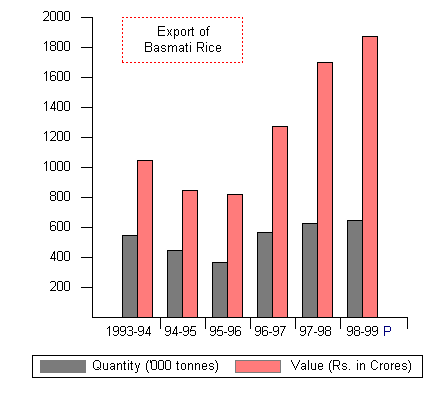Basmati Rice in India : Its Export Potential
Basmati Rice in India : Its Export Potential |
EXPORT EARNINGS
The export earnings from the export of total rice (Basmati and other than Basmati) during 1998-99 was Rs. 6,200.80 crores which accounts for 4.38% of total national export earnings of 1,41,603.53 crores. The total earnings from Basmati Rice during 1998-99 was Rs. 1,886.25 crores which accounts for 1.33% of total national export earnings. Similarly, export earnings from agricultural exports during 1998-99 was Rs. 25,224.63 crores which accounts for 17.81% of total national export earnings. The percentage share of rice exports to the total agricultural exports during 1998-99 was 24.58% in which the share of Basmati Rice was 7.5%.
 |
The percentage share of Basmati Rice to the total rice exports during 1998-99 was 32.42%. These stats are shown in Table-6.
| Table-6 : Percentage Share of Export of Basmati |
|
It is evident from the above table that export earnings from Basmati Rice during 1998-99 alone constitutes nearly one-third (32.42%) of the total export earnings from rice. Thus, Basmati Rice being a lucrative export commodity, its market is indeed vast. The export of Basmati Rice is increasing in the recent past (as shown in Table-5). It was 5,23,000 tonnes during 1996-97 and 6,00,000 tonnes were exported during 1998-99. Thus, there was an increase of 12.8% in export of Basmati Rice during 1998-99 over the export of 1996-97. This trend indicates that Basmati Rice has got good export potential in the international markets.
Therefore developmental and production activities may be strengthened in such a way to increase the production of quality Basmati Rice needed for export. This in turn would enable India to earn more foreign exchange for the development of the nation. The plant breeders with their sustained and systematic research efforts have successfully evolved high yielding semi-dwarf Basmati Rice varieties such as - Pusa Basmati-1, Kasturi and Haryana Basmati-1. These varieties are responding well to higher dose of nitrogenous fertilizers and giving higher yields per hectare as compared to traditional Basmati varieties. Thus, these varieties have offered potential to increase area and production under cultivation of Basmati Rice. In fact, Pusa Basmati-1 has been accepted by the Farmers and Consumers largely due to its ability of high yield and qualities that are more or less similar to indigenous Basmati Rice.
|